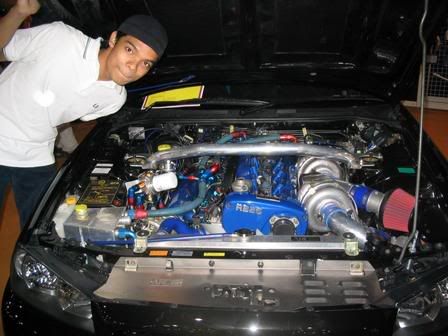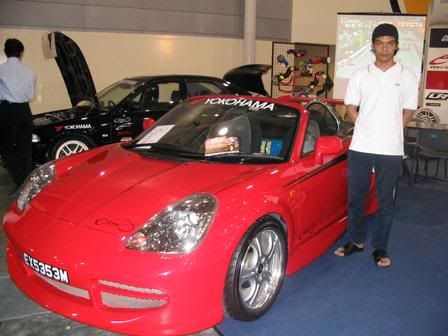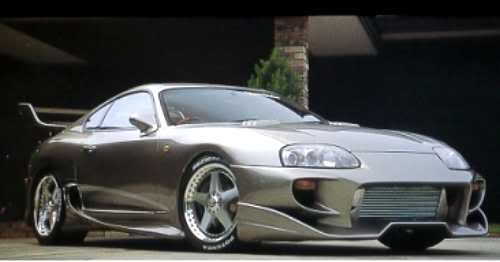suspensions............
Suspension Springs For Better Handling
The stock springs on your vehicle are normally wound, meaning that their coil pitch stays the same all the way up the spring. Majority of aftermarket makers of springs manufacturer progressive-type springs. We recommend getting progressively wound springs because the coil pitch gets tighter the closer to the top of the spring you get giving the spring increasing resistance, the more it is compressed.
For normal driving, you'll use mostly the lower 3 or 4 winds to soak up the average bumps and potholes, but when you get into harder driving like cornering at higher speeds for example, the springs are being compressed more so they resist more creating better stability. You want to reduce the suspension travel at the top end of the spring resulting in less body roll, and better road handling.
Lowering Springs
The fact that the springs are progressively wound is what accounts for the lowering factor. The springs aren't made shorter - they're just wound differently. Of course the material that aftermarket springs are made of is usually a higher grade than factory spec simply because it's going to be expected to handle more loads.
Since springs need tension to operate properly, you should NEVER cut your stock springs to give your car a lower look. By doing so, you are not only jeopardizing your cars handling but you are also putting your, your passengers and fellow drivers in danger by driving with defective parts. You'll also have a wobbling bounce every time you ride over a bump in the road.
Strut Braces
If you're serious about your car's handling performance, you will be able to get far better handling out of your car by fitting a couple of other accessories to it. The first thing you should look at is a strut brace. When you corner, the whole car's chassis is twisting slightly. In the front (and perhaps at the back, but not so often) the suspension pillars will be moving relative to each other because there's no physical link between them. A strut brace bolts across the top of the engine to the tops of the two suspension posts and makes that physical contact. The result is that the whole front suspension setup becomes a lot more rigid and there will be virtually no movement relative to each side. In effect, you're adding the fourth side to the open box created by the subframe and the two suspension pillars.
Anti-Roll Bars (Sway Bars/Stabilizers)
No, these aren't the things that are bolted inside the car in case you turn it over - those are rollover cages. Anti-roll bars do precisely what their name implies - they combat the roll of a car on it's suspension as it corners. They're also known as sway-bars or anti-sway-bars. Almost all cars have them fitted as standard, and all have scope for improvement. From the factory they are biased towards ride comfort. Stiffer aftermarket items will increase the roadholding but you'll get reduced comfort because of it. It's a catch-22 situation. Fiddling with your roll stiffness distribution can make a car uncomfortable to ride in and extremely hard to handle if you get it wrong. The anti-roll bar is usually connected to the front, lower edge of the bottom suspension joint. It passes through two pivot points under the chassis, usually on the subframe and is attached to the same point on the opposite suspension setup. Effectively, it joins the bottom of the suspension parts together.
When you head into a corner, the car begins to roll out of the corner. For example, if you're cornering to the left, the car body rolls to the right. In doing this, it's compressing the suspension on the right hand side. With a good anti-roll bar, as the lower part of the suspension moves upward relative to the car chassis, it transfers some of that movement to the same component on the other side. In effect, it tries to lift the left suspension component by the same amount. Because this isn't physically possible, the left suspension effectively becomes a fixed point and the anti-roll bar twists along its length because the other end is effectively anchored in place. It's this twisting that provides the resistance to the suspension movement.
You can buy cars with active anti-roll technology now. These sense the roll of the car into a corner and deflate the relevant suspension leg accordingly by pumping fluid in and out of the shock absorber. It's a high-tech, super expensive version of the good old mechanical anti-roll bar. You can buy anti-roll bars as an aftermarket addon. They're relatively easy to fit because most cars have anti-roll bars already. Take the old one off and fit the new one. In the case of rear suspension, the fittings will probably already be there even if the anti-roll bar isn't.
Typical anti-roll bar (swaybar) kits include the uprated bar, a set of new mounting clamps with polyurethane bushes, rose joints for the ends which connect to the suspension components, and all the bolts etc that will be needed.
The stock springs on your vehicle are normally wound, meaning that their coil pitch stays the same all the way up the spring. Majority of aftermarket makers of springs manufacturer progressive-type springs. We recommend getting progressively wound springs because the coil pitch gets tighter the closer to the top of the spring you get giving the spring increasing resistance, the more it is compressed.
For normal driving, you'll use mostly the lower 3 or 4 winds to soak up the average bumps and potholes, but when you get into harder driving like cornering at higher speeds for example, the springs are being compressed more so they resist more creating better stability. You want to reduce the suspension travel at the top end of the spring resulting in less body roll, and better road handling.
Lowering Springs
The fact that the springs are progressively wound is what accounts for the lowering factor. The springs aren't made shorter - they're just wound differently. Of course the material that aftermarket springs are made of is usually a higher grade than factory spec simply because it's going to be expected to handle more loads.
Since springs need tension to operate properly, you should NEVER cut your stock springs to give your car a lower look. By doing so, you are not only jeopardizing your cars handling but you are also putting your, your passengers and fellow drivers in danger by driving with defective parts. You'll also have a wobbling bounce every time you ride over a bump in the road.
Strut Braces
If you're serious about your car's handling performance, you will be able to get far better handling out of your car by fitting a couple of other accessories to it. The first thing you should look at is a strut brace. When you corner, the whole car's chassis is twisting slightly. In the front (and perhaps at the back, but not so often) the suspension pillars will be moving relative to each other because there's no physical link between them. A strut brace bolts across the top of the engine to the tops of the two suspension posts and makes that physical contact. The result is that the whole front suspension setup becomes a lot more rigid and there will be virtually no movement relative to each side. In effect, you're adding the fourth side to the open box created by the subframe and the two suspension pillars.
Anti-Roll Bars (Sway Bars/Stabilizers)
No, these aren't the things that are bolted inside the car in case you turn it over - those are rollover cages. Anti-roll bars do precisely what their name implies - they combat the roll of a car on it's suspension as it corners. They're also known as sway-bars or anti-sway-bars. Almost all cars have them fitted as standard, and all have scope for improvement. From the factory they are biased towards ride comfort. Stiffer aftermarket items will increase the roadholding but you'll get reduced comfort because of it. It's a catch-22 situation. Fiddling with your roll stiffness distribution can make a car uncomfortable to ride in and extremely hard to handle if you get it wrong. The anti-roll bar is usually connected to the front, lower edge of the bottom suspension joint. It passes through two pivot points under the chassis, usually on the subframe and is attached to the same point on the opposite suspension setup. Effectively, it joins the bottom of the suspension parts together.
When you head into a corner, the car begins to roll out of the corner. For example, if you're cornering to the left, the car body rolls to the right. In doing this, it's compressing the suspension on the right hand side. With a good anti-roll bar, as the lower part of the suspension moves upward relative to the car chassis, it transfers some of that movement to the same component on the other side. In effect, it tries to lift the left suspension component by the same amount. Because this isn't physically possible, the left suspension effectively becomes a fixed point and the anti-roll bar twists along its length because the other end is effectively anchored in place. It's this twisting that provides the resistance to the suspension movement.
You can buy cars with active anti-roll technology now. These sense the roll of the car into a corner and deflate the relevant suspension leg accordingly by pumping fluid in and out of the shock absorber. It's a high-tech, super expensive version of the good old mechanical anti-roll bar. You can buy anti-roll bars as an aftermarket addon. They're relatively easy to fit because most cars have anti-roll bars already. Take the old one off and fit the new one. In the case of rear suspension, the fittings will probably already be there even if the anti-roll bar isn't.
Typical anti-roll bar (swaybar) kits include the uprated bar, a set of new mounting clamps with polyurethane bushes, rose joints for the ends which connect to the suspension components, and all the bolts etc that will be needed.


 A site For All u Car lovers..........
A site For All u Car lovers..........
1 Comments:
Thank you!
My homepage | Please visit
Post a Comment
<< Home